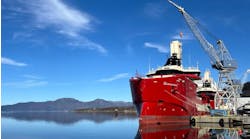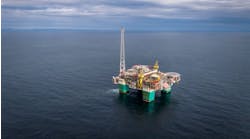Testing shows applications for various fibers
Rigo L. M. Boxman, Peter J. CloosThe taut leg mooring system with synthetic fibers is now in use by Petrobras in Brazil. The low excursions due to the high efficiency of the system and the small footprint on the seabed are the main reasons for application of taut leg mooring (TLM).
Akzo Nobel
This paper presents the results of a study comparing the use of different synthetic materials in a TLM mooring system. The following projects with AKZO Nobel involvement are currently in progress or have already been completed. The lab tests and results are as follows:
- Norsk Hydro joint industry project (completed): Static and dynamic testing of 750-ton and 1,500-ton ropes. Materials: Diolen "Oceanic" polyester, aramid. Conclusion: Polyester ropes are suitable for deepwater mooring applications.
- NEL/TTI joint industry project (July 1997-mid-1998): Testing of synthetic ropes in the 500-1,500 ton range. Goal: Determination of engineering parameters.
- Det Norske Veritas (completion scheduled for early 1998): Testing of synthetic ropes in the 500-750 range. Goal: Establishment of certification method, with test methods and engineering data.
- Petrobras: Substitution of lines of Diolen "Oceanic" and another polyester in an all-steel mooring system (1995)
- Elf: Substitution of a Diolen "Oceanic" polyester 500-meter-long, 500-ton line in a steel mooring system. Installed in September 1997.
- Statoil: Installation of three ropes of Diolen "Oceanic" and another polyester for mooring a barge, scheduled for September 1997.
- Deepstar: Installation of three ropes of Diolen "Oceanic" and another polyester in series in a mooring system for a 10-ton buoy in the Gulf of Mexico. Goal: Monitoring of installation in May 1996.
In conjunction with the development of the TLM system, a Noble Denton-guided joint industry project produced a design guide at the end of 1997. The guide was based on a former joint industry project (Tethers 2000). The mooring line materials covered were aramid, polyester, polyamide, and HMPE.
The TLM system appears to be accepted as an established deepwater mooring system. While this applies primarily to Diolen "Oceanic" polyester ropes, other synthetic materials also have attractive properties for TLM systems.
Materials comparison
To choose the best solution for a mooring problem, the mooring designer has to be aware of the available options. Among them is the variation in raw materials making up the mooring lines.In order to get a feeling for the behavior of different materials in a mooring system, an Akzo Nobel investigation has been done, with the synthetic materials Enka Nylon polymide 6.6, Diolen polyester, and Twaron aramid in a TLM system.
The investigation included the calculation of mooring systems characteristics by means of a computer program, tailor-made by Marin in the Netherlands. The mooring system used as the basis for the calculations was a semisubmersible structure with a 55° TLM system.
For the investigation, a standard floating platform has been used with 12 mooring lines.
The floating platform data included the following: dimensions - 120 meters by 120 meters; weight 60,000 tons, three mooring lines on each corner; and mooring line azimuth angle of -15° + n x 30°.
The semisubmersible platform was theoretically situated in the Gulf of Mexico. The environmental data for a Gulf of Mexico 100-year design storm are as follows: wind - 56 meters per second; current - 1.5 meters per second; significant wave height - 12 meters; wave period - 12 seconds; and wave spectrum - Jonswap (shape factor 2.0).
Three synthetic materials were used for this study. For all cases, three ropes, with increasing breaking load, are used. The characteristics of the ropes appear in an accompany chart. The properties were derived from a Marlow Ropes product brochure and are based on the Superline parallel strand construction.
The type name "Oceanic" used in this article refers to the tailor-made marine finish on the different materials. The main differences between the ropes are the rope diameter at various breaking loads and the elongation at break and hence the modules or rope stiffness.
TLM analysis
In order to design a mooring system, one has to take into account the maximum allowed platform displacement and the mooring line loads, according to the API recommendations for the envisaged project. Due to the lack of experience with fiber ropes in these applications, certification institutes demand a dynmaic analysis of the mooring system.In the case of a TLM system, this analysis is more straightforward than it is for an all-steel mooring system. Due to the low mass of the fiber mooring line, the lines run straight to the anchor, so, the maximum dynamic load in the mooring line coincide with the maximum displacement.
An all-steel mooring system, on the other hand, possesses high mass, and so, a catenary line form. Therefore, the peak load coincides with the rate of displacement of the mooring line. For this study, the maximum platform offset was calculated by summation of the quasi-static offset and the dynamic offset. The maximum load can be calculated from the maximum offset.
The quasi-static analysis was carried out with AKZOSEMI software, specially designed for this purpose. The program computes the mean environmental forces - as induced by wind, waves, and current - acting on a semisubmersible. Coefficients for the effect on the platform of wind, wave, and current forces were obtained from databases.
The mean offset of the semisubmersible was calculated from the data on enviroment, water depth, platform design, and mooring system design. Mooring line forces were computed from catenary formulas in which linear axial elasticity was taken into account.
Dynamic analysis
For a fiber mooring line in a TLM system, the maximum load coincides with the maximum platform offset. From motion response curves for a typical semisubmersible, the maximum wave frequency offset was estimated. The estimation was based on the maximum regular wave accuring in the wave spectrum.Starting from the Gulf of Mexico 100-year design storm, the horizontal and vertical offsets were estimated at 12 meters and 10 meters, respectively. For the maximum horizontal platform offset, the quasi-static offset was increased with this dynamic offset due to wave action. The low-frequency wave drift motions were considered to be of minor importance, largely due to the much stronger effect of wind load on the semisubmersible.
The peak load was calculated for the maximum strain of the mooring line, which coincides with the maximum horizontal and vertical offset. For the purpose of this calculation, drift stiffness was used for the quasi-static portion of displacement, and storm stiffness for the dynamic portion. The peak load was the sum of these two effects.
While it is true that the analysis involves considerable simplification, the principal effects on line loads are accounted for, and therefore it is believed that the results have significant predictive value.
Results
The results presented below are for this particular platform. For other constellations, the absolute results will be different, but the trends will be the same.• Displacement: Enka Nylon, Oceanic polymide, Diolen Oceanic polyester, and Twaron Oceanic aramid, between them, cover a wide range of displacements. The larger the rope, the smaller the maximum horizontal displacements.
For greater ease of handling, one can substitute a 1250-ton Enka Nylon Oceanic rope for a 750-ton Diolen Oceanic polyester rope. Similarly, a 750-ton Twaron Oceanic aramid rope can replace a 1250-ton Diolen Oceanic polyester rope. An accompanying figure shows the comparisons • Peak load: The calculated peak load as a percentage of the guaranteed minimum breaking load (GMBL) of the fiber ropes is shown in an accompanying figure. In lower water depths the added displacement, due to the wave and wind induced dynamic offset, is significant and develops as a high peak load. Only Enka Nylon Oceanic can accommodate this sort of load, due to the high stretch of the material. In deeper water, the effect of dynamic offset is much smaller.
API recommendations limit dynamic peak load to 60% of GMBL. It appeaers that there is a minimum water depth in which the various fibers can be used. For this minimum water depth the highest GMBL is needed.
• Minimum water depth: The 60% peak load criterion translates into a minimum water depth in which the ropes can be used. The ropes with a higher breaking load induce a lower peak load as a percentage of GMBL. It follows that these ropes are suitable for lower water depths. The minimum water depths in which the various fiber ropes can be used are shown in an accompanying illustration.
For example, a 1250-ton polymide rope can be used in waters deep 450 meters and greater. However, in greater water depths, a mooring system with polyamide will exceed the maximum allowable displacement. Polyester ropes can be used in water depths greater than 875 meters, and aramid ropes in water depths of 1,000 meters and greater.
Conclusions
The study shows that fiber-based TLM systems can be used in water depths greater than 450 meters. At the lower depth range, only Enka Nylon Oceanic can absorb the large peak loads, because of its' high stretch, but as water depth increases, a point is reached where the maximum allowed horizontal displacement is exceeded. At this point, Diolen Oceanic polyester will take over. For ultra-deepwater and in applications where smaller rope diameters are preferred, Twaron Oceanic is the best option.These are the results for a standard mooring problem. Applications with other floating platform dimensions and other situations may produce a different outcome. But the overall conclusion is that for any taut leg mooring situation there is a fiber mooring solution.
Copyright 1998 Oil & Gas Journal. All Rights Reserved.


